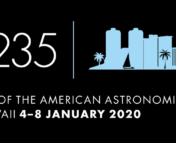In this series of posts, we sit down with a few of the keynote speakers of the 233rd AAS meeting to learn more about them and their research. You can see a full schedule of their talks here!
Colors of planet formation
Planet formation studies have come a long way since the first images of protoplanetary disks were released by the Hubble Space Telescope(HST) in 1995. In the last decade, there has been to a significant push to improve the sensitivity and resolutions at which we can look at the footprints of planet formation across the lifetime of these disks. “With the quality of observations we can get from the Atacama Large Millimeter Array (ALMA) and in near future with the next-generation instruments on the James Webb Space Telescope and Extremely Large Telescopes, this is the most exciting time to study protoplanetary disks,” says Dr. Catherine Espaillat. Dr. Espaillat, Assistant Professor of Astronomy at Boston University, will be giving a plenary talk at #AAS233 about her work on studying the structures and variability in protoplanetary disks and what that can tell us about the formation pathways of planets.

Dr. Catherine Espaillat, Boston University.
Dr. Espaillat and her group use multi-wavelength observations of disks ranging from radio to X-ray to understand how the properties of dust and gas in a disk evolve as the disk goes through different stages. Recent observations of substructures (rings, gaps, and spirals) in disks suggest that the process of dust settling and growth into planetesimals, leading up to the formation of solid cores of planets, can happen quite early on in a disk’s life. However, the environment around young stars at the center of these disks can be quite dynamic. Dr. Espaillat’s group has been recently focussing on understanding this variability by observing some of these protoplanetary disks in UV using HST-STIS instrument. Broadband observations of disks in UV enable the extraction of excess stellar luminosity coming solely from the accretion. Taking these observations over the intervals of a few months can reveal how the accretion rate changes in these very young disks.
Dr. Espaillat has been working on topics related to disks and planet formation since her graduate studies. Having a general interest in astronomy since a very young age, she “didn’t realize you could have a job as an astronomer” until she got to college. Coming from a family of immigrant parents with a working-class background, astronomy was not quite on her radar when she had to choose her undergraduate major. Starting off as a pre-medical student, “the plan was still to be a rich doctor and build a telescope in my backyard,” she says. But after taking up the Astronomy 101 course in her sophomore year she realized that one could actually do some cool professionally, and she changed her major to Astronomy in her sophomore year. Since then she has jumped around research areas beginning by studying cataclysmic variables as an undergraduate, later looking at AGNs, and starting with protoplanetary disks for her PhD. Her guiding principle has always been to do something which is both exciting and interesting. “It is important to have something you really enjoy and which makes you feel positive to navigate through the challenging (and sometimes not so great!) parts of the academia,” she says.
Throughout her academic career, Dr. Espaillat has been actively involved in mentorship and outreach programs focussing especially on mentoring underrepresented minorities in academia. “The drive to do outreach comes from having some really great mentors that helped her figure out her path in academia,” she says. During her time as a graduate student, she became keenly aware that one of the major reasons for disparities in academia is the lack of access to information — basically not knowing the right people and the right questions to ask. As a graduate student, she started working on a peer support program (senior graduate students mentoring undergraduates) for underrepresented groups in STEM “to make the known unknown and demystify academia so that the right answers to the questions aren’t available based on sheer luck.” Later as a postdoctoral researcher at Harvard University she led the Women in Science, Technology, Engineering, and Mathematics (WISTEM) Mentor Program which facilitated mentorship of women undergraduates in STEM by women graduate students in the related field of study. Currently, she is the Director of the League for Underrepresented Minorities in Astronomy (LUMA), a peer mentoring program for women of color postdocs and graduate students in Astronomy. The idea of the program is to get together regularly to discuss issues like work-life balance, handling rejection, and impostor syndrome.
What advice does she have for students about to start their careers? “Have confidence and try your best to figure out the challenges in front of you,” she says, “but also remember that struggle and rejections are a part of academia and not a sign of failure, and this is true at all levels of academia.” It’s important to reassure yourself that we are all a work in progress, always evolving and changing with time, and even though we don’t talk about it too often, we all face struggles. She also emphasizes that leaving academia is not a sign of failure but just another path you have chosen for yourself. “It’s easy to equate success with good grades, positions — essentially external validation, but it’s important to work towards defining success in terms of something which is more in your control”, she says, “and one of the ways you can do that is believing that your best is enough!”
Be sure to check out Dr. Espaillat’s plenary talk “From Disks to Planets: Observing Planet Formation in Disks Around Young Stars” at 11:40 AM on Thursday, January 10 at #AAS233.




